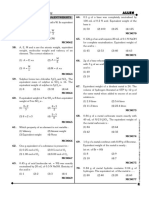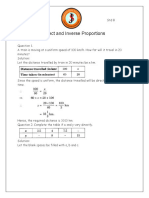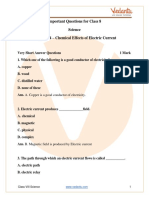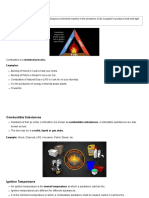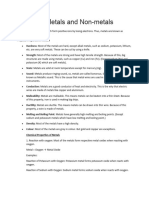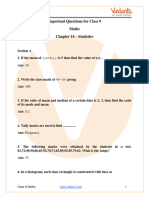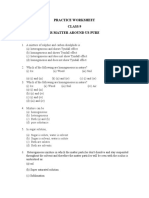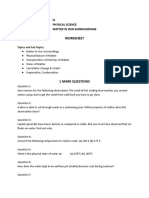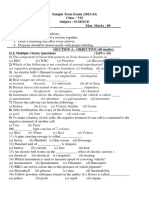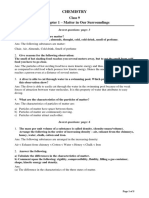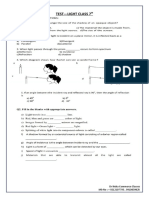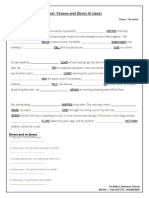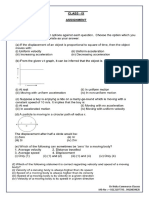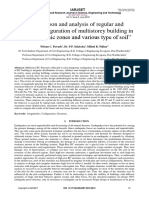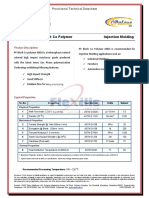Class 9 Science - Chapter 1 Matter in Our Surroundings PDF
Uploaded by
Gaurav SethiClass 9 Science - Chapter 1 Matter in Our Surroundings PDF
Uploaded by
Gaurav SethiClass 9 Science - Chapter 1 Matter In Our Surroundings
Page: 3
1. Which of the following are matter?
Chair, air, love, smell, hate, almonds, thought, cold, lemon water, smell of perfume.
Solution:
The following substances are matter:
Chair
Air
Almonds
Lemon water.
2. Give reasons for the following observation:
The smell of hot sizzling food reaches you several meters away, but to get the smell from cold food you
have to go close.
Solution:
Particles in the air, if fueled with higher temperatures, acquire high kinetic energy which aids them
to move fast over a stretch. Hence the smell of hot sizzling food reaches a person even at a distance
of several meters.
3. A diver can cut through water in a swimming pool. Which property of matter does this observation
show?
Solution:
The diver is able to easily cut through the water in the swimming pool because of the weak forces of
attraction between water molecules. It is this property of water that attributes to easy diving.
4. What are the characteristics of the particles of matter?
Solution:
The characteristics of particles of matter are:
(a) Presence of intermolecular spaces between particles
(b) Particles are in constant motion
(c) They attract each other
Page: 6
5. The mass per unit volume of a substance is called density. (density=mass/volume). Arrange the
following in the order of increasing density - air, exhaust from the chimneys, honey, water, chalk,
cotton and iron. Solution:
The following substances are arranged in the increasing density:
• Air
• Exhaust from chimney
• Cotton
• Water
• Honey
• Chalk
• Iron
6. Answer the following.
a) Tabulate the differences in the characteristics of matter.
b) Comment upon the following: rigidity, compressibility, fluidity, filling a gas container, shape,
kinetic energy and density.
Dr Neha Commerce Classes
Mb No :—9212107793 , 9910839625
Solution:
a) The difference in the characteristics of the three states of matter.
Characteristics Solid Liquid Gas
Shape Fixed shape No Fixed shape No Fixed shape
Volume Fixed volume Fixed volume No Fixed volume
Intermolecular force Maximum Less than solids Very less
Intermolecular space Very less More than solids maximum
Rigidity/Fluidity Rigid/cannot flow Can flow/not rigid Can flow/not rigid
Compressibility negligible compressible Highly compressible
b) (i) Rigidity: It is the propensity of a substance to continue to remain in its shape when treated with
an external force.
(ii) Compressibility: It is the attribute of the particles to contract its intermolecular space when
exposed to an external force thereby escalating its density.
(iii)Fluidity: It is the ability of a substance to flow or move about freely.
(iv) Filling the gas container: The particles in a container take its shape as they randomly vibrate in
all possible directions.
(v) Shape: It is the definite structure of an object within an external boundary
(vi) Kinetic energy: Motion allows particles to possess energy which is referred to as kinetic energy.
The increasing order of kinetic energy possessed by various states of matter are:
Solids < Liquids < Gases
Mathematically, it can be expressed as K.E =12mv2, where 'm' is the mass and 'v' is the velocity of
the particle.
(vii) Density: It is the mass of a unit volume of a substance. It is expressed as: d = M/V,
where 'd' is the density, 'M' is the mass and 'V' is the volume of the substance
7. Give reasons
a) A gas fills completely the vessel in which it is kept.
b) A gas exerts pressure on the walls of the container.
c) A wooden table should be called a solid.
d) We can easily move our hand in the air but to do the same through a solid block of wood we
need a karate expert.
Solution:
a) Kinetic energy possessed by gas particles is very high which allows them to randomly move across
all directions when contained, hence the particles fills the gas vessel entirely.
b) Gas molecules possess high kinetic energy, due to which they are under constant motion inside the
container in random directions which causes them to hit the walls of the container and hence create
vibrations. These collisions with the walls of the container generate pressure.
c) A wooden table should be called a solid as it possesses all the properties of a solid such as:
• Definite size and shape
• Intermolecular attraction between closely packed particles.
• It is rigid and cannot be compressed
d) Molecules in gases are loosely packed as compared to solid molecules which are densely packed.
Hence we are easily able to break the force of attraction when we move our hand through air but find
it difficult to break through a solid (because of greater forces of attraction between molecules) which
a karate expert is able to smash with the application of a lot of force.
Dr Neha Commerce Classes
Mb No :—9212107793 , 9910839625
8. Liquids generally have a lower density than solids. But you must have observed that ice floats on
water. Find out why.
Solution:
Density of ice is less than the density of water. The low density of ice can be attributed to the small pores it
has which allows it to trap air hence ice floats on water.
Page: 9
9. Convert the following temperature to Celsius scale:
a. 300K b. 573K
Solution:
As 0°C=273K
a) 300K= (300-273) °C = 27°C
b) 573K= (573-273) °C = 300°C
10. What is the physical state of water at:
a. 250°C b. 100°C ?
Solution:
a) At 250°C - Gaseous state since it is beyond its boiling point.
b) At 100°C - It is at the transition state as the water is at its boiling point. Hence it would be
present in both liquid and gaseous state.
11. For any substance, why does the temperature remain constant during the change of state?
Solution:
It is due to the latent heat as the heat supplied to increase the temperature of the substance is used up to
transform the state of matter of the substance hence the temperature stays constant.
12. Suggest a method to liquefy atmospheric gases.
Solution:
It can be achieved by either increasing the pressure or decreasing the temperature which ultimately leads to
the reduction of spaces between molecules.
Page: 10
13. Why does a desert cooler cool better on a hot dry day?
Solution:
It is because the temperature is high and it is less humid on a hot dry day which enables better evaporation.
High levels of this evaporation provide better cooling effects.
14. How does the water kept in an earthen pot (matka) become cool during summer?
Solution:
An earthen pot is porous in nature. These tiny pores facilitate penetration of water and hence their
evaporation from the pot surface. The process of evaporation requires energy which is contributed by water
in the pot as a result of which water turns cooler.
15. Why does our palm feel cold when we put on some acetone or petrol or perfume on it?
Solution:
Acetone, petrol, and perfume are volatile substances that get evaporated when they come in contact with air.
Evaporation is facilitated as it uses energy from palm hence leaving a cooling effect on our palms.
16. Why are we able to sip hot tea or milk faster from a saucer rather than a cup?
Solution:
A saucer has a larger surface area than a cup which promotes quicker evaporation hence the tea or milk in a
saucer cools down faster.
17. What type of clothes should we wear in summer?
Dr Neha Commerce Classes
Mb No :—9212107793 , 9910839625
Solution:
In summer, it is preferred to wear light-colored cotton clothes because light color reflects heat and cotton
materials have pores that absorb sweat, facilitating their evaporation hence causing a cooling effect in the
skin
Page: 12
1. Convert the following temperature to Celsius scale.
(a) 293K (b) 470K
Solution:
0°C=273K
(b) 293K= (293 - 273)°C = 20°C
(c) 470K= (470 - 273)°C = 197°C
(d)
2. Convert the following temperatures to the Kelvin scale.
(a) 25°C (b) 373°C
Solution:
0°C = 273K
(a) 25°C = (25+273)K = 298K
(b) 373°C = (373+273)K = 646K
3. Give reason for the following observations:
(a) Naphthalene balls disappear with time without leaving any solid.
(b) We can get the smell of perfume while sitting several meters away.
Solution:
(a) At room temperature, naphthalene balls undergo sublimation wherein they directly get converted
from a solid to a gaseous state without having to undergo the intermediate state, i.e., the liquid state.
(b) Molecules of air move at a higher speed and have large intermolecular spaces. Perfumes comprise of
flavored substances that are volatile which scatters quickly in air, becoming less concentrated over a
distance. Hence, we are able to smell perfume sitting several meters away.
4. Arrange the following in increasing order of forces of attraction between the particles - water,
sugar, oxygen.
Solution:
Oxygen (gas) < water (liquid) < sugar (solid)
5. What is the physical state of water at -
(a) 25°C (b) 0°C (c) 100°C?
Solution:
(a) At 25°C, the water will be in liquid form (normal room temperature)
(b) At 0°C, the water is at its freezing point, hence both solid and liquid phases are observed.
(c) At 100°C, the water is at its boiling point, hence both liquid and gaseous state of water (water
e) vapor) are observed.
6. Give two reasons to justify -
(a) Water at room temperature is a liquid.
(b) An iron almirah is a solid at room temperature.
Solution:
(a) Transition in the states of matter of water occurs at 0°C and 100°C. At room temperature,
water is in the liquid state, thereby exhibiting all the properties of a liquid such as
• Water flows at this temperature
• It has a fixed volume and it takes the shape of its container
Dr Neha Commerce Classes
Mb No :—9212107793 , 9910839625
(b) The melting and boiling points of iron are as high as 1538°C and 2862°C respectively. The
room temperature is about 20-25 °C. Hence iron almirah is a solid at room temperature.
7. Why is ice at 273K more effective in cooling than water at the same temperature?
Solution:
Water at this temperature(273K) is less effective than ice as ice can readily form water through absorption of
ambient heat energy as opposed to water which does not exhibit this property as it already possesses
additional latent heat of fusion so does not require extra heat. Hence ice cools rapidly compared to water at
the same temperature.
8. What produces more severe burns, boiling water or steam?
Solution:
Steam produces severe burns. It is because it is an exothermic reaction that releases high amount of heat
which it had consumed during vaporization.
9. Name A, B, C, D, E and F in the following diagram showing a change in its state.
Solution:
A: Melting (or) fusion (or) liquefaction
B: Evaporation (or) vaporization
C: Condensation
D: Solidification
E: Sublimation
F: Sublimation
Dr Neha Commerce Classes
Mb No :—9212107793 , 9910839625
You might also like
- Class 7 Science Chapter Reproduction in PlantsNo ratings yetClass 7 Science Chapter Reproduction in Plants37 pages
- Chemical Effects of Electric Current WS 1No ratings yetChemical Effects of Electric Current WS 12 pages
- CBSE Class 9 Science Worksheet - Atoms and Molecules - 1No ratings yetCBSE Class 9 Science Worksheet - Atoms and Molecules - 12 pages
- Sound Class 8 Extra Questions Very Short Answer QuestionsNo ratings yetSound Class 8 Extra Questions Very Short Answer Questions14 pages
- Importante Questions For CBSE Class 8 Science Chapter 14No ratings yetImportante Questions For CBSE Class 8 Science Chapter 146 pages
- NCERT Exemplar Solution Class 8 Science Chapter 10 1No ratings yetNCERT Exemplar Solution Class 8 Science Chapter 10 112 pages
- Class 7 Icse Chem Chemical Reaction Worksheet0% (1)Class 7 Icse Chem Chemical Reaction Worksheet2 pages
- Important Questions For CBSE Class 7 Science Chapter 5 - Acids, Bases and SaltsNo ratings yetImportant Questions For CBSE Class 7 Science Chapter 5 - Acids, Bases and Salts5 pages
- CBSE Sample Papers For Class 8 Science Practice Paper 1100% (2)CBSE Sample Papers For Class 8 Science Practice Paper 13 pages
- Combustion & Flame Chapter Notes - Science Class 8No ratings yetCombustion & Flame Chapter Notes - Science Class 820 pages
- Class 8 - Science - Chemical Effects of Electric Current0% (1)Class 8 - Science - Chemical Effects of Electric Current7 pages
- CBSE 9, Physics, CBSE - Motion, Sample QuestionsNo ratings yetCBSE 9, Physics, CBSE - Motion, Sample Questions1 page
- Science Chapter - (Reaching The Age of Adolescence) Class 8No ratings yetScience Chapter - (Reaching The Age of Adolescence) Class 87 pages
- CBSE Class 8 Science Sample Paper Set 5: Each Question Carriers 1 Mark: Choose The Correct Answers: (5 X 1 5 Marks)No ratings yetCBSE Class 8 Science Sample Paper Set 5: Each Question Carriers 1 Mark: Choose The Correct Answers: (5 X 1 5 Marks)3 pages
- CBSE Class 10 Science Chapter 8 How Do Organisms Reproduce - Important Questions 2023-24No ratings yetCBSE Class 10 Science Chapter 8 How Do Organisms Reproduce - Important Questions 2023-2426 pages
- Ncert Solutions Class 6 Geography Chapter 7No ratings yetNcert Solutions Class 6 Geography Chapter 76 pages
- CBSE Class 9 Maths Chapter 14 - Statistics Important Questions 2023-24No ratings yetCBSE Class 9 Maths Chapter 14 - Statistics Important Questions 2023-2465 pages
- Science Class Ix Chapter 01 Matter in Our Surroundings Practice Paper 01 2024 AnswersNo ratings yetScience Class Ix Chapter 01 Matter in Our Surroundings Practice Paper 01 2024 Answers5 pages
- Class-11th Physics Byjus Topicwise Notes CH 1 - Applications of DifferentiationNo ratings yetClass-11th Physics Byjus Topicwise Notes CH 1 - Applications of Differentiation5 pages
- NCERT - Solutions-Class8 - Reproduction in Animals ScienceNo ratings yetNCERT - Solutions-Class8 - Reproduction in Animals Science6 pages
- Microorganisms: Friend and Foe Class 8 Notes Science Chapter 2No ratings yetMicroorganisms: Friend and Foe Class 8 Notes Science Chapter 25 pages
- Class 8 Science Worksheet - Chemical Effect of Electric Current Part B100% (1)Class 8 Science Worksheet - Chemical Effect of Electric Current Part B1 page
- Delhi Public School, Bangalore South Revision-Reported Speech Ex.1 Reporting QuestionsNo ratings yetDelhi Public School, Bangalore South Revision-Reported Speech Ex.1 Reporting Questions3 pages
- Atmospheric-Pollution Important-Qs Important-Questions - ICSENo ratings yetAtmospheric-Pollution Important-Qs Important-Questions - ICSE1 page
- CBSE Class 9 Science Sample Paper SA 1 Set 2 PDF0% (1)CBSE Class 9 Science Sample Paper SA 1 Set 2 PDF2 pages
- NCERT Solutions Class 7 Science Chapter 15 LightNo ratings yetNCERT Solutions Class 7 Science Chapter 15 Light5 pages
- Worksheet: Class: IX Subject: Physical Science: Matter in Our SurroundingsNo ratings yetWorksheet: Class: IX Subject: Physical Science: Matter in Our Surroundings6 pages
- Notes of CH 6 Physical and Chemical Changes Class 7th ScienceNo ratings yetNotes of CH 6 Physical and Chemical Changes Class 7th Science3 pages
- Class 8 Science Worksheet - Reproduction in Animals Part B100% (1)Class 8 Science Worksheet - Reproduction in Animals Part B3 pages
- Chapter 2 - Acids, Bases and Salts: Intext QuestionsNo ratings yetChapter 2 - Acids, Bases and Salts: Intext Questions10 pages
- Delhi Public School, Bangalore - East Chemistry Chemical Effects of Electric Current Name: Class: Viii Sec: DateNo ratings yetDelhi Public School, Bangalore - East Chemistry Chemical Effects of Electric Current Name: Class: Viii Sec: Date4 pages
- Class-8-Maths-Chap-2-Linear Eqations in One Variable-Work Sheet-3 of 4No ratings yetClass-8-Maths-Chap-2-Linear Eqations in One Variable-Work Sheet-3 of 42 pages
- Class 7 Work Book Answers Acid Bases and SaltsNo ratings yetClass 7 Work Book Answers Acid Bases and Salts2 pages
- Class 9 Science - Chapter 2 Is Matter Around Us Pure PDFNo ratings yetClass 9 Science - Chapter 2 Is Matter Around Us Pure PDF6 pages
- D A V Group of Schools: (Chennai & Ranipet Common Periodic Test Ii - 2020-2021 ScienceNo ratings yetD A V Group of Schools: (Chennai & Ranipet Common Periodic Test Ii - 2020-2021 Science11 pages
- A COMPLETE GUIDE TO M.C.Q (CLASS-9,SOCIAL SCIENCE): CBSE MCQ SERIES -2 CLASS 9, #1From EverandA COMPLETE GUIDE TO M.C.Q (CLASS-9,SOCIAL SCIENCE): CBSE MCQ SERIES -2 CLASS 9, #1No ratings yet
- Human Eye and Colourful World - Class 10 ScienceNo ratings yetHuman Eye and Colourful World - Class 10 Science14 pages
- Class7 The Triangle and Its Properties WorksheetNo ratings yetClass7 The Triangle and Its Properties Worksheet3 pages
- Heat Class 7 Science Chapter 4 Work BookNo ratings yetHeat Class 7 Science Chapter 4 Work Book4 pages
- Test - Light Class 7: DR Neha Commerce Classes MB No:-9212107793, 9910839625No ratings yetTest - Light Class 7: DR Neha Commerce Classes MB No:-9212107793, 99108396253 pages
- Test - Light Class 7: DR Neha Commerce Classes MB No:-9212107793, 9910839625No ratings yetTest - Light Class 7: DR Neha Commerce Classes MB No:-9212107793, 99108396253 pages
- Class 9 Science - Chapter 3 Atoms and Molecules PDF100% (1)Class 9 Science - Chapter 3 Atoms and Molecules PDF5 pages
- Applications - Cathodic Protection DesignerNo ratings yetApplications - Cathodic Protection Designer5 pages
- A Probabilistic Analysis of Seismically Induced Permanent Movements in Earth Dams PDFNo ratings yetA Probabilistic Analysis of Seismically Induced Permanent Movements in Earth Dams PDF13 pages
- Topic 3.3 Modelling A Gas Roderick Notes 2017No ratings yetTopic 3.3 Modelling A Gas Roderick Notes 20175 pages
- VRF-PC-BN-001-US 014A21 LGProductCatalog MultiVIV 0115 20140117102146No ratings yetVRF-PC-BN-001-US 014A21 LGProductCatalog MultiVIV 0115 2014011710214640 pages
- Comparison and Analysis of Regular and Irregular Configuration of Multistorey Building in Various Seismic Zones and Various Type of SoilNo ratings yetComparison and Analysis of Regular and Irregular Configuration of Multistorey Building in Various Seismic Zones and Various Type of Soil7 pages
- Instant Download Engineering Physics Hitendra K Malik PDF All Chapters100% (1)Instant Download Engineering Physics Hitendra K Malik PDF All Chapters47 pages
- Polypropylene Impact Co Polymer Injection Molding: Provisional Technical DatasheetNo ratings yetPolypropylene Impact Co Polymer Injection Molding: Provisional Technical Datasheet2 pages
- Mechanics of Materials (AM 551) : P.R.Shaya 1No ratings yetMechanics of Materials (AM 551) : P.R.Shaya 135 pages
- Multiplex Cinema Halls: Design and Construction of Six Halls in The City of Mar Del PlataNo ratings yetMultiplex Cinema Halls: Design and Construction of Six Halls in The City of Mar Del Plata11 pages
- 17 - Curling Stresses in Concrete SlabsNo ratings yet17 - Curling Stresses in Concrete Slabs43 pages
- 242 Wikarta Kuliah IV Keseimbangan Benda TegarNo ratings yet242 Wikarta Kuliah IV Keseimbangan Benda Tegar21 pages
- 2022 Online Physics Olympiad: Open Contest: SponsorsNo ratings yet2022 Online Physics Olympiad: Open Contest: Sponsors14 pages
- A Reaction Mechanism - Is A: The Rate-Determining StepNo ratings yetA Reaction Mechanism - Is A: The Rate-Determining Step2 pages



